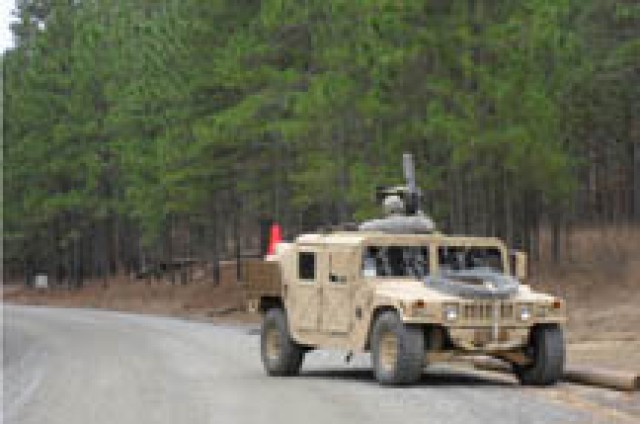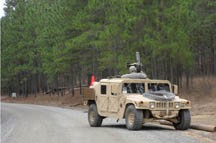
FORT POLK, LA. -- "No food! No water! No services!" This chorus echoed at every village they visited. While the troop commander conducted a "social" call with the town's mayor, the platoon leader prepared to distribute food and medical supplies to anxious villagers wearing traditional Afghan garb.
This was one of many scenes played out during a 3rd Squadron, 89th Cavalry Regiment, 4th Brigade Combat Team, 10th Mountain Division, full-spectrum operations training exercise, dubbed Operation Slugger Slam. The squadron conducted the exercise in the eastern corner of Fort Polk's training area during the first week of February.
Operation Slugger Slam challenged platoon and troop leadership to perform simultaneous stability, security and offensive tasks. The objective of the exercise was to train and mentor platoons and troop command-post personnel, including troop intelligence support teams, to effectively perform anticipated missions in a time-constrained environment. Leaders wanted to induce stress in ambiguous situations, just like a normal day in the hinterlands of Afghanistan.
The exercise was a fitting beginning to the squadron's countdown to deployment. During the course of Operation Slugger Slam, platoons gained invaluable experience with conducting operations along the full spectrum of conflict. They conducted route reconnaissance, village assessments and key-leader engagements. Platoons also reacted to ambushes and improvised explosive devices, identified and captured insurgent leaders and conducted day and night joint raids as they controlled helicopters and mortar fire. To ramp up the realism, Troop C, 5th Aviation Squadron, provided helicopters, 4th Brigade Special Troops Battalion provided a human intelligence collection team and the 162nd Infantry Brigade provided a team of trainer-mentors.
Lt. Col. Phil Chambers, commander, 3-89 Cav, spoke highly of the training.
"This exercise was a great example of the teamwork present on Fort Polk," said Chambers. "With the support of Lieutenant Colonel Hudson's 4th Battalion, 353rd Infantry (Regiment) trainer-mentors and the pilots from Lieutenant Colonel Chaisson's 5th Aviation Squadron, we were able to conduct realistic training at the level of a (Joint Readiness Training Center situational training exercise) lane."
The 18-hour lane started with an assessment of a local village and meeting with the mayor. A route-reconnaissance mission to provide humanitarian aid quickly followed.
Soldiers and leaders also increased their confidence in their abilities to interact with the local population through street-level engagements, conduct infrastructure assessments and quickly throw the switch to react to enemy contact.
Along the way, units had to negotiate IED hot boxes and likely ambush locations. Leaders designed each event to reward the platoon for the proper use of proven techniques. If they did not execute an event correctly, the platoon learned their lesson the hard way -- through tough opposing forces encounters.
As they negotiated the lane, platoons gathered bits of information that allowed the troop commander and his intelligence team to build a picture of the insurgent network. This information led to additional intelligence-driven operations such as a joint knock and search, night surveillance of IED hot boxes to identify IED emplacers and a night raid on an insurgent compound. The operation provided small unit leaders the experience of partnering with local police forces to conduct a complex joint operation.
Sgt. 1st Class Kyle West set the tone for his platoon with the respect he showed to his Afghan partners, and mentored them through some quick training and rehearsals with an eye to building their capacity to do their jobs in the future.
"The challenges on the modern battlefield are often complex and rarely understood," said West. "The STX lanes challenged my platoon in realistic situations, forcing us to think and react with 'outside the box' solutions."
Matching real-life conditions, designers dedicated many of the events to nonlethal nation-building efforts such as assessments of villages' vital services, engagements with local leaders and villagers on the street and distribution of humanitarian aid.
During the operation, the squadron worked with JRTC's Task Force 1 to validate their newest STX lane -- defend a combat outpost. Leaders selected Ghost Troop, the squadron's long-range dismounted reconnaissance troop, to take on this unfamiliar task. Capt. Kip Wickwire led his troop through the high-intensity defensive operations for 24 hours, using whatever assets were at hand to hold off a swarm of aggressive insurgents provided by 51st Chemical Company and professional OPFOR from 1st Battalion (Airborne), 509th Infantry Regiment.
Through the efforts of Ghost Troop's snipers, mortar team and two infantry platoons, the troop successfully held the outpost despite coordinated attacks from more than 60 insurgents. "It was a great learning event for the troops," said Wickwire. "Task Force 1 did a great job putting this all together, and I think this lane will really help prepare units going downrange."

Social Sharing